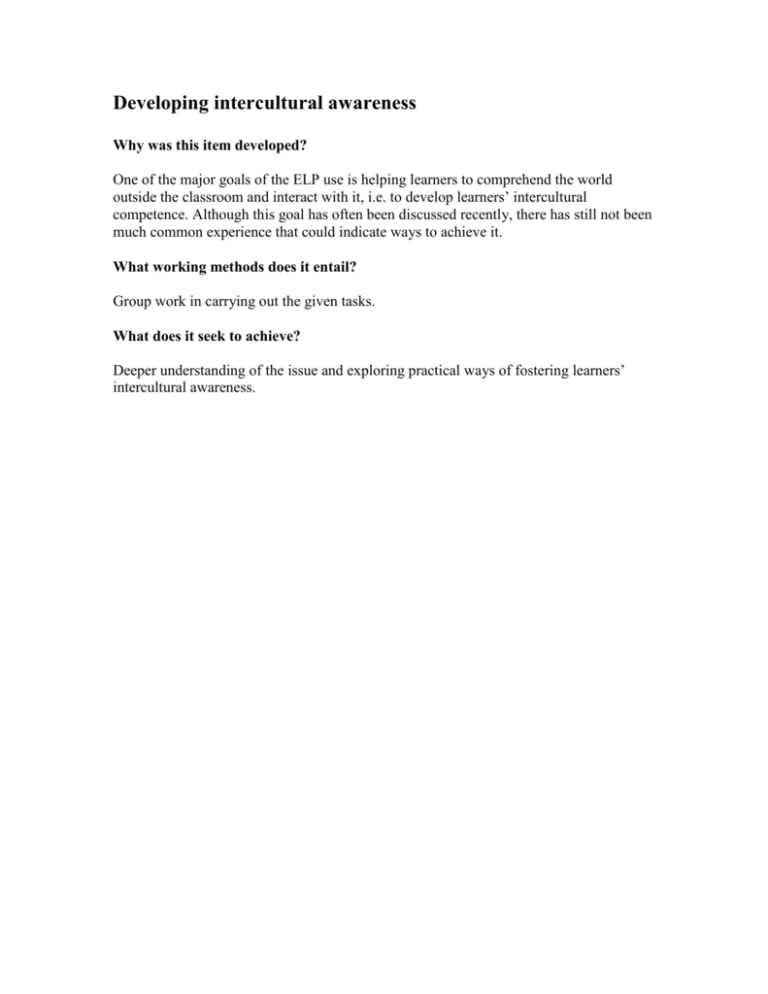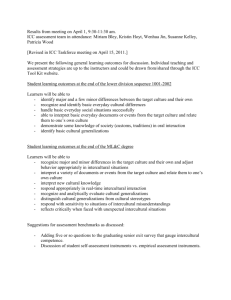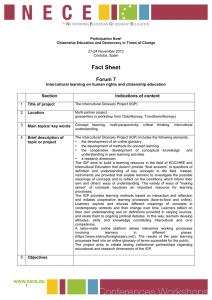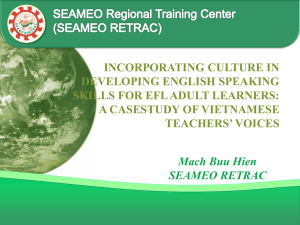Developing intercultural awareness
advertisement

Developing intercultural awareness Why was this item developed? One of the major goals of the ELP use is helping learners to comprehend the world outside the classroom and interact with it, i.e. to develop learners’ intercultural competence. Although this goal has often been discussed recently, there has still not been much common experience that could indicate ways to achieve it. What working methods does it entail? Group work in carrying out the given tasks. What does it seek to achieve? Deeper understanding of the issue and exploring practical ways of fostering learners’ intercultural awareness. Consider the following ideas Attitudes and skills that make up the intercultural competence are for example * Limiting the possibility of misinterpretation * Dealing with or tolerating ambiguity * Accepting difference Based on Rose, Ch. (2005). Intercultural learning 1. http://www.teachingenglish.org.uk/think/methodology/intercultural1.shtml Interculturally competent learners should be able to … 1. have a good understanding and awareness of their own culture 2. be aware of how their culture is seen from outside, by other countries or cultures 3. understand or see the target culture from its own perspectives, (i.e. understand and be aware of what other people think of their own culture) 4. be aware of how they see the target culture Rose, Ch. (2005). Intercultural learning 2. http://www.teachingenglish.org.uk/think/methodology/intercultural2.shtml How can you help your learners to develop these competences? What specific activities can you do? Compare your ideas with the following activities 1. Learners produce a guidebook, poster or webpage for visitors to their town, country or region. This should not only describe famous sites and places to visit, stay or eat, but also give visitors advice about what they may find strange or unusual about their own culture. 2. Learners read articles or extracts from books, newspapers, magazines or websites written by people who have visited their town, country or region. 3. Learners familiarise themselves with sources of information about the target culture. Again, newspapers and websites can be an invaluable source of reading materials here. Films and literary texts often depict their own culture. 4. The non-native teacher has a valuable role to play here, being a person from one culture who has certain amount of knowledge and/or experience of the target culture. If students have visited the target culture, they can recount their experiences – perhaps by giving a written or oral presentation with advice for other students. If there is not such source available, students can do a valuable creative writing activity – imagining a journey into the target culture, predicting the problems and misunderstandings they may encounter and creatively resolving them. At this fourth step, students can measure their knowledge and awareness of the target culture at the end of the course compared to the beginning of the course. How have their attitudes and perceptions changed (if at all)? Rose, Ch. (2005). Intercultural learning 2. http://www.teachingenglish.org.uk/think/methodology/intercultural2.shtml











